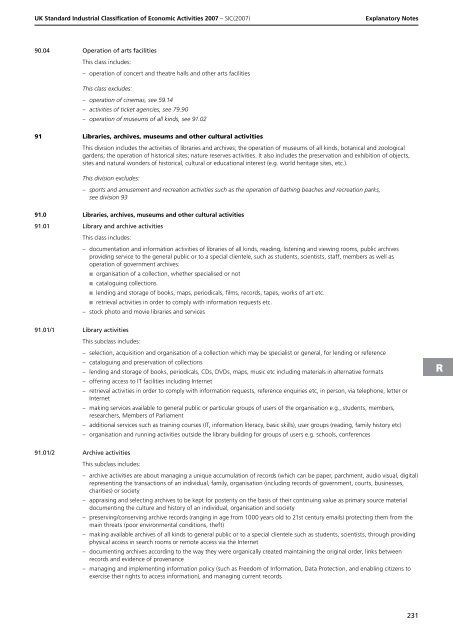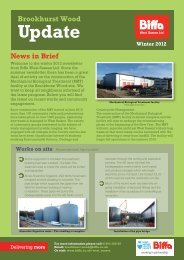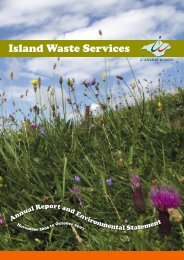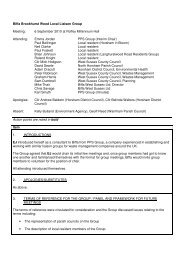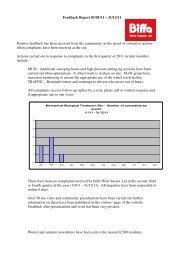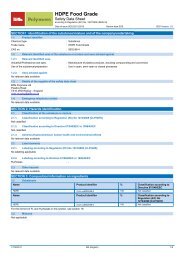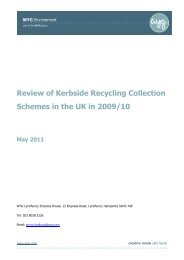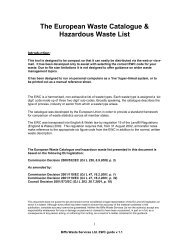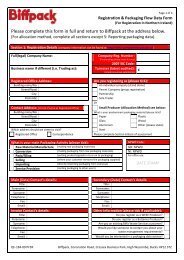detailed explanation for each SIC code - Biffa
detailed explanation for each SIC code - Biffa
detailed explanation for each SIC code - Biffa
Create successful ePaper yourself
Turn your PDF publications into a flip-book with our unique Google optimized e-Paper software.
UK Standard Industrial Classification of Economic Activities 2007 – <strong>SIC</strong>(2007)<br />
Explanatory Notes<br />
90.04 Operation of arts facilities<br />
This class includes:<br />
–<br />
operation of concert and theatre halls and other arts facilities<br />
This class excludes:<br />
–<br />
–<br />
–<br />
operation of cinemas, see 59.14<br />
activities of ticket agencies, see 79.90<br />
operation of museums of all kinds, see 91.02<br />
91 Libraries, archives, museums and other cultural activities<br />
This division includes the activities of libraries and archives; the operation of museums of all kinds, botanical and zoological<br />
gardens; the operation of historical sites; nature reserves activities. It also includes the preservation and exhibition of objects,<br />
sites and natural wonders of historical, cultural or educational interest (e.g. world heritage sites, etc.).<br />
This division excludes:<br />
–<br />
sports and amusement and recreation activities such as the operation of bathing b<strong>each</strong>es and recreation parks,<br />
see division 93<br />
91.0 Libraries, archives, museums and other cultural activities<br />
91.01 Library and archive activities<br />
This class includes:<br />
– documentation and in<strong>for</strong>mation activities of libraries of all kinds, reading, listening and viewing rooms, public archives<br />
providing service to the general public or to a special clientele, such as students, scientists, staff, members as well as<br />
operation of government archives:<br />
–<br />
■ organisation of a collection, whether specialised or not<br />
■ cataloguing collections<br />
■ lending and storage of books, maps, periodicals, films, records, tapes, works of art etc.<br />
■ retrieval activities in order to comply with in<strong>for</strong>mation requests etc.<br />
stock photo and movie libraries and services<br />
91.01/1 Library activities<br />
This subclass includes:<br />
–<br />
–<br />
–<br />
–<br />
–<br />
–<br />
–<br />
–<br />
selection, acquisition and organisation of a collection which may be specialist or general, <strong>for</strong> lending or reference<br />
cataloguing and preservation of collections<br />
lending and storage of books, periodicals, CDs, DVDs, maps, music etc including materials in alternative <strong>for</strong>mats<br />
offering access to IT facilities including Internet<br />
retrieval activities in order to comply with in<strong>for</strong>mation requests, reference enquiries etc, in person, via telephone, letter or<br />
Internet<br />
making services available to general public or particular groups of users of the organisation e.g., students, members,<br />
researchers, Members of Parliament<br />
additional services such as training courses (IT, in<strong>for</strong>mation literacy, basic skills), user groups (reading, family history etc)<br />
organisation and running activities outside the library building <strong>for</strong> groups of users e.g. schools, conferences<br />
R<br />
91.01/2 Archive activities<br />
This subclass includes:<br />
– archive activities are about managing a unique accumulation of records (which can be paper, parchment, audio visual, digital)<br />
representing the transactions of an individual, family, organisation (including records of government, courts, businesses,<br />
charities) or society<br />
– appraising and selecting archives to be kept <strong>for</strong> posterity on the basis of their continuing value as primary source material<br />
documenting the culture and history of an individual, organisation and society<br />
– preserving/conserving archive records (ranging in age from 1000 years old to 21st century emails) protecting them from the<br />
main threats (poor environmental conditions, theft)<br />
– making available archives of all kinds to general public or to a special clientele such as students, scientists, through providing<br />
physical access in search rooms or remote access via the Internet<br />
– documenting archives according to the way they were organically created maintaining the original order, links between<br />
records and evidence of provenance<br />
– managing and implementing in<strong>for</strong>mation policy (such as Freedom of In<strong>for</strong>mation, Data Protection, and enabling citizens to<br />
exercise their rights to access in<strong>for</strong>mation), and managing current records<br />
231


